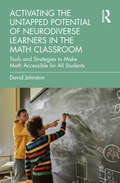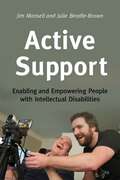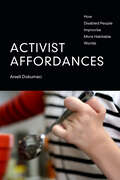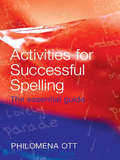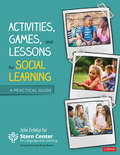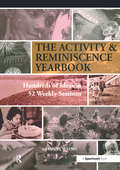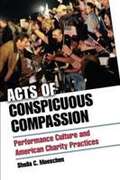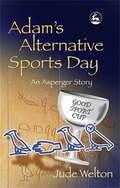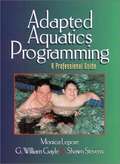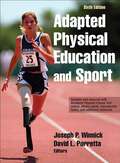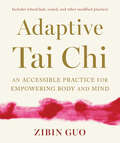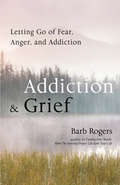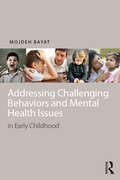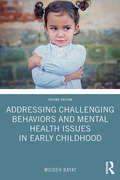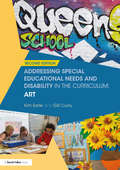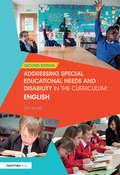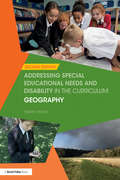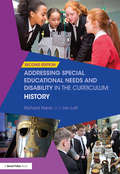- Table View
- List View
Activating the Untapped Potential of Neurodiverse Learners in the Math Classroom: Tools and Strategies to Make Math Accessible for All Students
by David JohnstonAll students deserve access to a rich and meaningful math curriculum. This book guides middle and high school teachers toward providing all learners – including neurodiverse students – with the support necessary to engage in rewarding math content. Students who receive special education services often experience a limited curriculum through practices that create long-term disadvantages and increase gaps in learning. The tools and strategies in this book help teachers better understand their students to move them closer to their potential. Chapters include differentiation, assessment, classroom structure, and learning targets. Both general education math teachers who have not been trained in special education support and special education teachers with a limited background in standards-based math pedagogy will learn new skills to improve their teaching from this practical resource.
Active Citizenship and Disability
by Andrew Power Janet E. Lord Allison S. DeFranco Andrew Power Janet E. Lord Allison S. DefrancoThis book provides an international comparative study of the implementation of disability rights law and policy focused on the emerging principles of self-determination and personalisation. It explores how these principles have been enshrined in the United Nations Convention on the Rights of Persons with Disabilities and how different jurisdictions have implemented them to enable meaningful engagement and participation by persons with disabilities in society. The philosophy of 'active citizenship' underpinning the Convention - that all citizens should (be able to) actively participate in the community - provides the core focal point of this book, which grounds its analysis in exploring how this goal has been imagined and implemented across a range of countries. The case studies examine how different jurisdictions have reformed disability law and policy and reconfigured how support is administered and funded to ensure maximum choice and independence is accorded to people with disabilities.
Active Support
by Jim Mansell Julie Beadle-BrownActive Support is a proven model of care that enables and empowers people with intellectual disabilities to participate fully in all aspects of their lives. This evidence-based approach is particularly effective for working with people with more severe disabilities, and is of growing interest to those responsible for providing support and services. The authors provide a comprehensive overview of Active Support and how it can be used in practice, based on the theory and research underpinning the methods involved. They describe how to engage people with intellectual disabilities in meaningful activity as active participants, and look at the communication style needed to foster positive relationships between carers and the people they are supporting. Highlighting the main issues for those trying to put Active Support into practice, they explain what is needed on a day-to-day basis to support the implementation, improvement and maintenance of the approach, along with possible solutions for the difficulties they may encounter. Finally, they look at how to integrate Active Support with other person-centred approaches, drawing on examples from various organisations and individual case studies. The definitive text on Active Support, this book will be essential reading for anyone professionally concerned with the quality of life of people with intellectual disabilities, including psychologists, behaviour specialists, social workers, care managers, occupational therapists and inspectors and regulators of services, as well as families.
Activist Affordances: How Disabled People Improvise More Habitable Worlds
by Arseli DokumaciFor people who are living with disability, including various forms of chronic diseases and chronic pain, daily tasks like lifting a glass of water or taking off clothes can be difficult if not impossible. In Activist Affordances, Arseli Dokumacı draws on ethnographic work with differently disabled people whose ingenuity, labor, and artfulness allow them to achieve these seemingly simple tasks. Dokumacı shows how they use improvisation to imagine and bring into being more habitable worlds through the smallest of actions and the most fleeting of movements---what she calls “activist affordances.” Even as an environment shrinks to a set of constraints rather than opportunities, the improvisatory space of performance opens up to allow disabled people to imagine that same environment otherwise. Dokumacı shows how disabled people’s activist affordances present the potential for a more liveable and accessible world for all of us.
Activities for Successful Spelling: The Essential Guide
by Philomena OttThis highly practical activity workbook is linked to the core text How to Manage Spelling Successfully and has been designed to support dyslexic students practise the spelling strategies and methods recommended in that book. This activity book can be used separately, or as part of an integrated programme for building students' spelling skills at home or at school. Suitable for mainstream classrooms, pupils undertaking additional literacy support in small groups, and for one-to-one teaching of individuals with specific learning difficulties including dyslexia, this excellent resource contains activities suitable for use at different stages of development, and for use with adults as well as school students. Each section contains a range of multi-sensory activities, including word searches, simple crossword puzzles and dictation exercises. This is an essential classroom companion for anyone helping struggling spellers.
Activities, Games, and Lessons for Social Learning: A Practical Guide
by Stern Center for Language and LearningIn these games, the prize is success in school—and life. Having good social skills doesn’t just affect classroom behavior—it’s the key to making learning stick. When students improve their self-regulation, social communication, and perspective-taking competencies, they are better prepared to challenge themselves academically, take on tough tasks, and collaborate with teachers and classmates to achieve real, lasting school success. And since these skills also improve life outside school, the benefits come full circle. Designed for both explicit instruction and "learning by doing," this practical guide provides hands-on activities that are easily adapted into any curriculum and can be used in general education, special education, after-school settings, and in the home. The design of each game keeps kids engaged and motivated, while educators benefit from clear, thorough explanations that unpack the complexities of social learning. Other behind-the-scenes features include: Evidence-based, teacher-tested lessons Anecdotes and real-world examples Links to relevant research Expansion ideas for applying learned skills to broader situations Templates and reproducibles for easy implementation This curated collection of activities puts social-learning theory into practice, helping even the most challenging children develop the social skills necessary for real success in school—and beyond.
Activities, Games, and Lessons for Social Learning: A Practical Guide
by Stern Center for Language and LearningIn these games, the prize is success in school—and life. Having good social skills doesn’t just affect classroom behavior—it’s the key to making learning stick. When students improve their self-regulation, social communication, and perspective-taking competencies, they are better prepared to challenge themselves academically, take on tough tasks, and collaborate with teachers and classmates to achieve real, lasting school success. And since these skills also improve life outside school, the benefits come full circle. Designed for both explicit instruction and "learning by doing," this practical guide provides hands-on activities that are easily adapted into any curriculum and can be used in general education, special education, after-school settings, and in the home. The design of each game keeps kids engaged and motivated, while educators benefit from clear, thorough explanations that unpack the complexities of social learning. Other behind-the-scenes features include: Evidence-based, teacher-tested lessons Anecdotes and real-world examples Links to relevant research Expansion ideas for applying learned skills to broader situations Templates and reproducibles for easy implementation This curated collection of activities puts social-learning theory into practice, helping even the most challenging children develop the social skills necessary for real success in school—and beyond.
Activity & Reminiscence Handbook: Hundreds of Ideas in 52 Weekly Sessions
by Danny WalshThis comprehensive guide provides a bumper book of original resource material for reminiscence and activities with older people for a whole year! Containing 52 sections of ideas and resource materials for each week of the year, this is an invaluable resource for activity organisers and group leaders in residential, day care and hospitals, and for anyone working with older people. There is a theme for each week, eg. Animals and pets, with corresponding ideas for social events, reminiscence, exercises and games, quizzes, art and crafts, as well as 'this week in history', good ideas', 'discussion topics', 'homework' and the option to personalise the week by recording local anniversaries and events alongside personal landmarks and details. The ideas are easy to use and are relevant for both groups and individuals, including those with mental health and cognitive problems. Some activities require some physical effort, others mental effort, but they are all adaptable to be fun and achievable. This book also includes an introduction to the nature and value of reminiscence and activities, and guidelines on 'how to do it'. Written by the author of "Groupwork Activities", this comprehensive resource provides hundreds of activity and reminiscence ideas - a fantastic resource.
Acts of Conspicuous Compassion: Performance Culture and American Charity Practices
by Moeschen Sheila C."Acts of Conspicuous Compassion" investigates the relationship between performance culture and the cultivation of charitable sentiment in America, exploring the distinctive practices that have evolved to make the plea for charity legible and compelling. From the work of 19th-century melodramas to the televised drama of transformation and redemption in reality TV s "Extreme Makeover: Home Edition," "Acts of Conspicuous Compassion" charts the sophisticated strategies employed by various charity movements responsible for making organized benevolence alluring, exciting, and seemingly uncomplicated. Sheila C. Moeschen brokers a new way of accounting for the legacy and involvement of disabled people within charity specifically, the articulation of performance culture as a vital theoretical framework for discussing issues of embodiment and identity dislodges previously held notions of the disabled existing as passive, objects of pity. This work gives rise to a more complicated and nuanced discussion of the participation of the disabled community in the charity industry, of the opportunities afforded by performance culture for disabled people to act as critical agents of charity, and of the new ethical and political issues that arise from employing performance methodology in a culture with increased appetites for voyeurism, display, and complex spectacle. "
Adam's Alternative Sports Day: An Asperger Story
by Jude Welton'This is a very useful book for any staff involved in teaching students on the autism spectrum. Its strength is its easy-to-read structure and the engaging illustrations, lists and notes. It meets the needs of many students and adults who find it hard to understand and cope with competition and unstructured events. I can strongly recommend this book to pupils between the ages of 6 and 13 years. It is a good idea for teachers or parents to read it to children and allow them to participate in the activities. It is also a good read for children who do not have Asperger's syndrome as it will help to develop their awareness.' - Good Autism Practice Nine-year-old Adam dreads Sports Day - he usually comes last in the races and never gets chosen for the team events. So he is delighted when Mr Williams, the head teacher, announces that this year there will be an Alternative Sports Day with some very different challenges. There will be quizzes, riddles to solve, and a treasure hunt - all the things that Adam enjoys. At last he'll have a chance of winning something. But as the competition runs high, how will Adam feel if his best friend Josie beats him to the Challenge Cup? And what will they do when they discover that James, the new boy in the class, is cheating? A fun and absorbing children's story, Adam's Alternative Sports Day also offers insights into how a child with Asperger Syndrome copes with the ups and downs and everyday challenges of school.
Adapted Aquatics Programming: A Professional Guide
by Monica Lepore G. William Gayle Shawn StevensThis text for aquatics instructors covers the various philosophies and issues relating to adapted aquatics programs; offers detailed information on skills and resources for adapted aquatics personnel; and discusses program enhancement, including model programs and how to modify fitness activities for participants with disabilities. Annotation c. Book News, Inc. , Portland, OR (booknews. com)
Adapted Physical Education And Sport
by Joseph P. Winnick David L. PorrettaThe field of adapted physical education and sport has undergone numerous changes in recent years. This new edition of Adapted Physical Education and Sport will help you stay on top of those changes and, in doing so, provide the highest-quality physical education and sport opportunities for students with disabilities.
Adapting Early Childhood Curricula For Children With Special Needs
by Deborah Chen Ruth Cook M. KleinAdapting Early Childhood Curricula for Children with Disabilities and Special Needs uses a developmental focus, rather than a disability orientation, to discuss typical and atypical child development and curricular adaptations. The integrated, non-categorical approach assumes that children are more alike than different in their development. The inclusive focus assumes that attitudes, environments, and intervention strategies can be adapted so that all young children with disabilities or other special needs can be included. <p><p> An essential text for today, and a valuable resource to take into the classroom tomorrow, this practical guide provides daily activities, evidence-based how-to strategies, and realistic lesson modifications that help facilitate truly inclusive classrooms. Aspiring educators will also learn to develop their collaboration and problem-solving skills to effectively work with families, colleagues, and paraprofessionals in supporting every child's positive development. <p> The 10th Edition is updated to include enhanced discussions on working with families, children, and professionals of diverse cultural and linguistic backgrounds and lifestyles; new tips for integrating Division for Early Childhood Recommended Practices; updated requirements for writing IEP goals and recommendations; and more.
Adapting Early Childhood Curricula for Children with Special Needs (Eighth Edition)
by Deborah Chen Ruth E. Cook M. Diane KleinThe book focuses on a blend of developmental and learning theories, with practical suggestions for delivery of services to young children with special needs and their families.
Adaptive Tai Chi: An Accessible Practice for Empowering Body and Mind
by Zibin GuoA simple and inclusive Tai Chi program, completely modifiable with helpful illustrations, that empowers people of all physical abilities to experience the transformative qualities of this art. Includes sequences for standing/moving, stationary standing, seated, and wheelchair.In Tai Chi Chuan, the traditional Chinese martial and healing art, we learn to overcome challenges by empowering the mind and transforming the body. Adaptive Tai Chi offers an innovative approach that speaks to this powerful idea and makes Tai Chi accessible and beneficial to people with a range of physical conditions or ambulatory impairment.The slow, circular, flowing, and graceful movements of Tai Chi require little space and no equipment, making it an ideal practice for people with different physical abilities (it&’s been included in the Paralympics since 2008). Adaptive Tai Chi introduces readers to the culture, philosophy, and physiology of Tai Chi—and gives readers four completely illustrated practices, each modified for different physical abilities, including conventional standing/moving, stationary standing, seated, and wheelchair sequences.Along with the complete illustrated adaptive Tai Chi sequences, Guo includes notes and philosophical insights into each practice. The complete program offered in Adaptive Tai Chi allows everyone to access the profound benefits of Tai Chi practice.
Addiction & Grief: Letting Go of Fear, Anger, and Addiction
by Barb RogersEmotional Recovery From AddictionAuthentic recovery is more than an attitude. It is based on emotional work that involves an honest appraisal of one's life. It is through dealing with unresolved feelings of grief and anger that one can truly heal from addiction.The emotional “bottom” of recovery. Just as one needs to hit bottom with drinking or using in order to begin recovery, eventually one will also hit an emotional “bottom” of fear, anger, and grief. And recovery can only start by first understanding how, when, and where those emotions took control. Author Barb Rogers challenges readers in recovery to investigate the unresolved grief and loss in their lives and helps readers navigate the impacts of those emotions—emotions that can lead back to using if not resolved.Finding healing and happiness. Recovery from addictions involves more than getting sober. It involves finding happiness, which can only happen if the emotional work is done as well. Negative emotions have the ability to weigh on us and influence both our decisions and the way we handle life’s challenges. If we continue to live with fear, anger, and grief, we aren’t really free from our addictions. The steps to recovery—authentic and complete recovery—involve healing from the deeper issues in our life. Learn more about:The emotional healing that goes hand-in-hand with addiction recoveryDealing with grief and resolving underlying issuesHow to find happiness after getting soberIf you learned from books like This Naked Mind, Rewired, The Mindfulness Workbook for Addiction, or A Gentle Path Through the Twelve Steps, then you’ll want to read Addiction & Grief.
Addressing Challenging Behaviors and Mental Health Issues in Early Childhood
by Mojdeh BayatA copublication with the Council for Exceptional Children (CEC), Addressing Challenging Behaviors and Mental Health Issues in Early Childhood focuses on research-based strategies for educators to address challenging behaviors of children during early childhood and elementary school years. Utilizing research from the fields of neuroscience, child development, child psychiatry, counselling and applied behavior analysis, the author suggests simple strategies for teachers to manage behaviors and promote mental health and resilience in children with challenging behaviors. Addressing Challenging Behaviors and Mental Health Issues in Early Childhood provides a framework for best practices which are empirically based and have been successfully utilized in the classroom. An appreciation of the deep understanding of culture as it affects curricular approaches, family engagement, and child growth and development is utilized throughout this comprehensive, multidisciplinary resource. Bayat references the most recent research in the field of child mental health and provides educational and intervention approaches that are appropriate for all children with and without disabilities.
Addressing Challenging Behaviors and Mental Health Issues in Early Childhood
by Mojdeh BayatNow in a fully updated second edition, this essential volume provides research-based strategies to help educators address challenging behaviors in early childhood and elementary years. Drawing on research and approaches from the fields of neuroscience, child development, child psychiatry, counseling, and applied behavior analysis, this text offers teachers simple strategies to manage behaviors and promote mental health and resilience in young children. Thoroughly updated to reflect new developments in neuroscience, trauma, and physical and mental health, this second edition also features an entirely new chapter on classroom approaches in child mental health, including the interaction of technology with challenging behaviors and mental health issues. Comprehensive, multidisciplinary, and culturally responsive, this critical resource provides new and experienced educators and coaches with educational and intervention approaches that are appropriate for all children, with and without disabilities.
Addressing Racism and Ableism in the Classroom and Teacher Education: Case Studies of Special Education Teachers of Color (Theory to Practice in Critical and Social Justice Education)
by Saili S. KulkarniAddressing Racism and Ableism in the Classroom and Teacher Education centers and elevates narratives of special education teachers of color, an overlooked and underserved population in public education, as a vehicle for analyzing the tensions of race and disability. Special education teachers of color, who work and may themselves live at the intersections of these complex identity constructs, are uniquely positioned to develop effective approaches to countering racism and ableism. This book offers five critical case studies of special education teachers of color, whose replicable practices span preschool through high school classrooms while also holding urgent implications for teacher education programs. Building toward an original framework that synthesizes DisCrit and Culturally Sustaining Pedagogies, these narratives refuse deficit readings of disability among students of color and instead prepare teachers to model collective joy and pride in their identities.
Addressing Special Educational Needs and Disability in the Curriculum: Art (Addressing SEND in the Curriculum)
by Kim Earle Gill CurryThe SEND Code of Practice (2015) reinforced the requirement that all teachers must meet the needs of all learners. This topical book provides practical, tried and tested strategies and resources that will support teachers in making art lessons accessible and interesting for all pupils, including those with special needs. The authors draw on a wealth of experience to share their understanding of special educational needs and disabilities and show how the art teacher can reduce or remove any barriers to learning. Offering strategies that are specific to the context of art teaching, this book will enable teachers to: develop students’ understanding, appreciation and enjoyment of art and design; advance students’ sense of enquiry about visual and tactile experiences; help pupils to realise their creative intentions, through the development of technical competence and manipulative skills; provide opportunities for personal and imaginative enquiry; sample a variety of art and design projects to use in their own lessons; plan the classroom layout and display to enhance learning; successfully train, and fully use the support of, their teaching assistants. An invaluable tool for continuing professional development, this text will be essential for secondary art teachers (and their teaching assistants) seeking guidance specific to teaching art to all pupils, regardless of their individual needs. The book will also be of interest to secondary SENCOs, senior management teams and ITT providers. Full of practical ideas and inspiration, and supported by free online resources, this is an essential tool for art teachers and teaching assistants and will help to deliver successful, inclusive lessons for all pupils.
Addressing Special Educational Needs and Disability in the Curriculum: Design And Technology (Addressing SEND in the Curriculum)
by Louise T. DaviesThe SEND Code of Practice (2015) reinforced the requirement that all teachers must meet the needs of all learners. This topical book provides practical, tried-and-tested strategies and resources that will support teachers in making design and technology lessons accessible and interesting for all pupils, including those with special educational needs. The author draws on a wealth of experience to share her understanding of special educational needs and disabilities and show how the design and technology teacher can reduce or remove any barriers to learning. Offering strategies that are specific to the context of design and technology teaching, this book will enable teachers to: better identify a student’s particular learning requirements; set inclusive design and making assignments which allow all students to participate and succeed; build students’ confidence in using a range of materials and tools; assist with design tasks where pupils take ownership of their work and learning; adapt the classroom environment to meet the needs of pupils; create a mutually supportive classroom which maximises learning opportunities. An invaluable tool for continuing professional development, this text will be essential for design and technology teachers (and their teaching assistants) seeking to include and motivate all pupils in their lessons, regardless of their individual needs. This book will also be of interest to secondary SENCOs, senior management teams and ITT providers. In addition to free online resources, a range of appendices provide design and technology teachers with a variety of pro forma and activity sheets to support effective teaching. This is an essential tool for design and technology teachers and teaching assistants, and will help to deliver successful, inclusive lessons for all pupils.
Addressing Special Educational Needs and Disability in the Curriculum: English (Addressing SEND in the Curriculum)
by Tim HurstThis book provides practical strategies and resources that have been proven effective in teaching English to pupils of all abilities, making English accessible, challenging and exciting. The author outlines important key principles that should underpin teaching and learning so that all pupils, including those with special educational needs, can enjoy the subject and make outstanding progress. The ideas and guidance draw on a wealth of experience, providing classroom activities and free online resources, which can be combined with different teaching approaches. A range of appendices provides teachers with real-life case studies and examples and templates for supporting pupils with SEND. Offering strategies that are specific to the context of English teaching, this book will enable teachers and their teaching assistants to: develop pupils’ understanding by engaging multi-sensory approaches; ensure all pupils are able to participate fully in lessons and achieve success; design and use individual plans for pupils with SEND; assess and adapt content and resources when differentiating materials for pupils with a wide range of learning needs; use formative assessments to measure learning and inform planning. An invaluable tool for whole-school continuing professional development, this fully revised text will be essential for teachers and their teaching assistants seeking guidance specific to teaching English to all pupils, regardless of their individual needs. This book will also be of interest to SENDCOs, learning support units and senior management teams as well as to teacher-training professionals.
Addressing Special Educational Needs and Disability in the Curriculum: Geography (Addressing SEND in the Curriculum)
by Helen HarrisThe SEND Code of Practice (2015) reinforced the requirement that all teachers must meet the needs of all learners. This topical book provides practical, tried and tested strategies and resources that will support teachers in making geography lessons accessible and interesting for all pupils, including those with special needs. The author draws on a wealth of experience to share her understanding of individual needs and show how the geography teacher can reduce or remove any barriers to learning. Offering strategies that are specific to the context of geography teaching, this book will enable teachers to: ensure all pupils are able to participate in every lesson; provide inclusive fieldwork opportunities that take into consideration the needs of all pupils; use formative assessments to measure learning and inform planning; plan the classroom layout and display to enhance learning; successfully use the support of their teaching assistants. An invaluable tool for continuing professional development, this text will be essential for middle school and secondary geography teachers (and their teaching assistants) who are committed to creating an inclusive learning environment for all pupils, regardless of their individual needs. The book will also be of interest to SENCOs and inclusion managers, curriculum co-ordinators, senior management teams and ITT providers. Full of practical ideas and inspiration, and supported by free online resources, this is an essential tool for geography teachers and teaching assistants who want to deliver successful, inclusive lessons for all pupils.
Addressing Special Educational Needs and Disability in the Curriculum: History (Addressing SEND in the Curriculum)
by Richard Harris Ian LuffThe SEND Code of Practice (2015) has reinforced the requirement that all teachers must meet the needs of all learners. This topical book provides practical, tried and tested strategies and resources that will support teachers in making history lessons accessible and exciting for all pupils, including those with special needs. The authors draw on a wealth of experience to share their understanding of special educational needs and disabilities and show how the history teacher can reduce or remove any barriers to learning. Offering strategies that are specific to the context of history teaching, this fully revised edition will enable teachers to: Make history education accessible and engaging to pupils of all abilities Create an inclusive classroom environment that responds to the emotional needs of the class and nurtures a culture of learning Develop inclusive practical demonstration and role play techniques to aid conceptual understanding Set assessment objectives Deploy in-class support effectively An invaluable tool for continuing professional development, this text will be essential for teachers (and their teaching assistants) seeking guidance specific to teaching history to all pupils, regardless of their individual needs. This book will also be of interest to SENDCOs, senior management teams and ITT providers. In addition to practical activities and supporting material contained in the book, there are also free online resources for readers to download and use in the preparation of successful, inclusive lessons for all pupils.
Addressing Special Educational Needs and Disability in the Curriculum: Maths (Addressing SEND in the Curriculum)
by Max WallaceThe SEND Code of Practice (2015) reinforced the requirement that all teachers must meet the needs of all learners. This topical book provides practical, tried and tested strategies and resources that will support teachers in making maths lessons accessible and interesting for all pupils, including those with special needs. The author draws on a wealth of experience to share his understanding of special educational needs and disabilities and show how the maths teacher can reduce or remove any barriers to learning. Offering strategies that are specific to the context of maths teaching, this book will enable teachers to: adopt a ‘problem solving’ approach to ensure students use and apply mathematics at all times during their learning develop students’ understanding of mathematical ideas structure lessons to empower and actively engage students create a mutually supportive classroom which maximises learning opportunities plan the classroom layout and display to enhance learning, for example displaying number lines, vocabulary lists and pupils’ work successfully train and fully use the support of their teaching assistants. An invaluable tool for continuing professional development, this text will be essential for secondary maths teachers (and their teaching assistants) seeking guidance specific to teaching maths to all pupils, regardless of their individual needs. This book will also be of interest to secondary SENCOs, senior management teams and ITT providers. In addition to free online resources, a range of appendices provide maths teachers with a variety of pro forma and activity sheets to support effective teaching. This is an essential tool for maths teachers and teaching assistants, and will help to deliver successful, inclusive lessons for all pupils.
